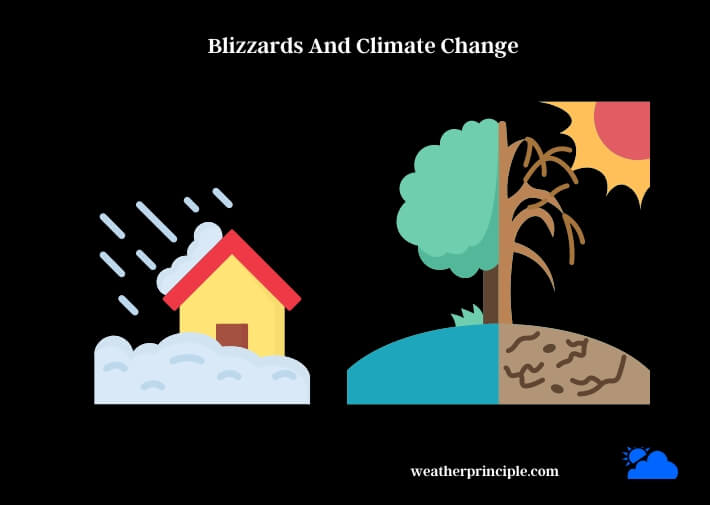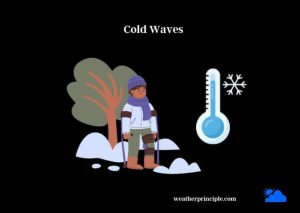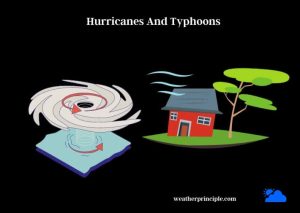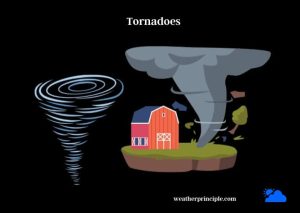Published on: May 3, 2023
Written by Shaown Khan / Fact-checked by Kader Khan
A blizzard is a severe snowstorm characterized by strong winds, heavy snowfall, and low visibility. The National Weather Service defines a blizzard as a storm with sustained winds or frequent gusts of 35 mph or greater, combined with falling or blowing snow that reduces visibility to less than a quarter-mile for at least three hours.
Blizzards differ from ordinary winter storms because of their extreme winds and the prolonged period of low visibility. While winter storms typically involve snowfall and cold temperatures, they do not necessarily have the high winds and low visibility that define a blizzard.
Blizzards are common in regions with cold climates, such as the polar and subpolar regions, the northeastern United States, and the northern European countries. However, they can also occur in areas that experience less frequent snowfall, such as the central United States or the United Kingdom, when the right meteorological conditions are present.
The Science Behind Blizzards
Meteorological Conditions for Blizzard Formation
Blizzards form when cold, dry air from the polar regions meets warm, moist air from the south. This convergence of air masses creates instability and often leads to the formation of a low-pressure system, which can intensify into a blizzard as it moves across the landscape. The key ingredients for a blizzard include cold temperatures, moisture, and strong winds.
The Role of Jet Stream in Blizzards
The jet stream, a high-altitude current of fast-moving air, plays a crucial role in the development of blizzards. It can steer weather systems and help to create the conditions needed for blizzard formation. When the jet stream dips southward, it can bring cold polar air into contact with warmer air from the south, setting the stage for a blizzard.
Interplay of Temperature, Wind, and Snowfall
For a blizzard to form, temperatures must be cold enough for snow to form and persist on the ground. Wind speeds need to be high enough to cause blowing snow and low visibility, while also providing the energy necessary for the storm to intensify. Finally, there must be a source of moisture to fuel the snowfall, which is typically provided by an approaching low-pressure system.
History’s Most Notable Blizzards
The Great Blizzard of 1888
The Great Blizzard of 1888, also known as the “Great White Hurricane,” was one of the most severe blizzards in American history. It struck the northeastern United States on March 11-14, 1888, and dumped up to 50 inches of snow in some areas. The storm caused the deaths of more than 400 people and led to the widespread adoption of underground utilities and improved weather forecasting.
The Storm of the Century (1993)
The Storm of the Century, which occurred on March 12-15, 1993, was a massive and powerful blizzard that affected much of the eastern United States, from Florida to Maine. It was responsible for more than 300 fatalities and caused billions of dollars in damage. The storm also set numerous records for snowfall, wind speeds, and low-pressure readings.
Other Significant Blizzards around the World
Blizzards have affected many regions around the world, including the United Kingdom’s Great Snowstorm of 1947, the 1972 Iran Blizzard, and the 1999 French Alps Blizzard. Each of these events serves as a reminder of the immense power and potential devastation that blizzards can cause.
Impacts of Blizzards
Environmental Impacts
Blizzards can have significant environmental impacts, including the disruption of ecosystems and the alteration of natural habitats. Heavy snowfall can damage trees and vegetation, while the weight of accumulated snow can cause roofs to collapse and roads to buckle. Additionally, blizzards can disrupt animal migration patterns and contribute to the decline of certain species.
Economic Consequences
Blizzards can lead to substantial economic losses, with businesses often forced to close and transportation networks grinding to a halt. Agricultural losses can result from damage to crops and livestock, while power outages and infrastructure damage can lead to costly repair and recovery efforts.
Health and Safety Issues
Blizzards pose significant health and safety risks, including hypothermia, frostbite, and carbon monoxide poisoning. Motor vehicle accidents are more likely during blizzards due to poor visibility and slippery road conditions. In extreme cases, blizzards can even result in fatalities due to accidents, exposure, or health complications exacerbated by the harsh conditions.
Blizzard Preparedness and Safety Measures
Preparing Your Home for a Blizzard
To prepare your home for a blizzard, ensure that your heating system is in good working order and that you have sufficient insulation to keep your home warm. Stock up on non-perishable food items, water, and necessary medications. Have a battery-powered radio and extra batteries on hand to stay informed about the storm’s progress and any emergency updates.
Essential Items to Stock Up on
In addition to food, water, and medications, make sure to have a well-stocked emergency kit, including flashlights, extra batteries, blankets, warm clothing, and a first-aid kit. Keep a supply of rock salt or sand for icy walkways, and have a snow shovel or snow blower ready for snow removal.
Staying Safe During and After a Blizzard
During a blizzard, stay indoors and avoid unnecessary travel. Dress in layers to stay warm and dry, and avoid overexertion when shoveling snow or performing other outdoor tasks. After the storm, check on neighbors, especially the elderly or those with disabilities, to ensure their safety and well-being.
Transportation Challenges in Blizzards
Impact on Road Transportation
Blizzards can make road transportation extremely dangerous or even impossible due to low visibility, slippery surfaces, and the potential for vehicles to become stranded. Road closures and traffic accidents are common during blizzards, and it is essential to stay informed about current road conditions and heed any travel advisories.
Air Travel Disruptions
Air travel is often heavily impacted by blizzards, with flight cancellations and delays being commonplace. Snow and ice can cause dangerous runway conditions, and visibility issues can make it impossible for pilots to navigate safely.
Navigating Public Transit During Blizzards
Public transit systems can also be affected by blizzards, with delays and cancellations likely due to snow-covered tracks and reduced visibility. If you must rely on public transportation during a blizzard, be prepared for potential disruptions and have a backup plan in case your preferred mode of transportation is unavailable.
Blizzards and Climate Change
The Connection Between Blizzards and Global Warming
While it may seem counter intuitive, global warming can actually lead to more intense and frequent blizzards in some regions. As the planet warms, the atmosphere can hold more moisture, providing the fuel for heavy snowfall during winter storms. Additionally, changes in atmospheric circulation patterns can lead to more frequent clashes between cold and warm air masses, creating the conditions necessary for blizzards to form.

Predicted Future Trends in Blizzard Activity
Climate models predict that blizzard activity may increase in some areas due to the changing climate. However, the exact relationship between climate change and blizzards is complex and not yet fully understood. Researchers are continuing to study the impact of climate change on extreme weather events, including blizzards, to improve our understanding and ability to predict future trends.
Impact of Climate Change on Blizzard-Prone Regions
As blizzard activity potentially increases due to climate change, communities in blizzard-prone regions may face increased risks and challenges. These include more frequent and severe infrastructure damage, greater strain on emergency services, and heightened public health concerns. Local governments and communities will need to adapt and invest in improved preparedness and response strategies to minimize the impact of future blizzards.
The Role of Technology in Blizzard Prediction and Management
Advanced Weather Forecasting Tools
Modern weather forecasting relies on advanced technology, including satellites, radar systems, and sophisticated computer models to predict the timing, location, and severity of blizzards. These tools have greatly improved the accuracy of blizzard forecasts, allowing for better preparation and more effective response strategies.
Remote Sensing Technologies for Blizzard Monitoring
Remote sensing technologies, such as satellite imagery and aerial photography, play a crucial role in monitoring blizzard conditions and assessing their impact. These technologies provide valuable data on snow cover, ice conditions, and other factors that can inform emergency response efforts and guide decision-making during and after a blizzard.
Innovations in Snow Removal and Infrastructure
Technological advancements have also led to innovations in snow removal equipment and infrastructure design, making it easier for communities to recover from blizzards. Improved snowplows, snow blowers, and road treatment methods help to clear roads more quickly and effectively, while new building materials and designs can better withstand the weight of heavy snow and ice.
Blizzard Stories: Human Resilience and Adaptation
Amazing Survival Stories
Throughout history, people have demonstrated incredible resilience and resourcefulness in the face of blizzards. Stories of survival and heroism, such as the “Children’s Blizzard” of 1888, remind us of the power of the human spirit to overcome adversity and inspire us to be better prepared for future storms.
Unique Cultural Practices and Traditions
Blizzards have shaped the culture and traditions of many communities around the world. From the Inuit people of the Arctic to the Sami people of Scandinavia, communities have developed unique ways of living, working, and celebrating in the face of extreme winter weather. These cultural practices remind us of the deep connection between humans and their environment and the importance of adaptation in the face of climate challenges.
The Influence of Blizzards on Art, Literature, and Film
Blizzards have long served as inspiration for artists, writers, and filmmakers, who have captured the beauty, danger, and drama of these powerful storms in their works. From classic novels like “The Shining” by Stephen King to films like “The Day After Tomorrow,” blizzards have played a prominent role in our cultural imagination.
Summary and Key Takeaways
Blizzards are powerful and potentially dangerous weather events that can have significant impacts on the environment, economy, and public health. Understanding the science behind blizzards, their historical occurrences, and the potential influence of climate change on their frequency and severity is crucial in preparing for and responding to these extreme winter storms.
As blizzards continue to challenge communities around the world, it is essential to invest in improved preparedness measures, technological advancements, and infrastructure upgrades. By learning from past events and embracing innovation, we can better protect ourselves and our communities from the dangers posed by blizzards.
Frequently Asked Questions (FAQs)
How is a blizzard different from a snowstorm?
A blizzard is a severe snowstorm characterized by strong winds, heavy snowfall, and low visibility. A snowstorm may involve snowfall and cold temperatures but does not necessarily have the high winds and low visibility that define a blizzard.
Can blizzards occur in regions outside of the polar and subpolar areas?
Yes, blizzards can occur in areas outside of the polar and subpolar regions when the right meteorological conditions are present. Cold temperatures, moisture, and strong winds are necessary for blizzard formation.
What steps can I take to prepare my home and family for a blizzard?
To prepare for a blizzard, ensure that your heating system is in good working order, stock up on non-perishable food items, water, and necessary medications, and have a battery-powered radio and extra batteries on hand. Additionally, gather essential items like flashlights, blankets, warm clothing, and a first-aid kit.
How do I stay safe if I get caught in a blizzard while driving?
If caught in a blizzard while driving, try to find a safe place to pull over and wait out the storm. Keep your vehicle’s engine running for warmth, but ensure the exhaust pipe is clear of snow to avoid carbon monoxide poisoning. Turn on your hazard lights and use a brightly colored cloth to signal for help.
Are blizzards becoming more frequent due to climate change?
The relationship between climate change and blizzards is complex, but some research suggests that blizzards may become more frequent and intense in certain regions as a result of climate change. The atmosphere’s increased capacity to hold moisture due to global warming can contribute to heavier snowfall during winter storms.



